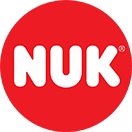
The pacifier study
Four pacifier shapes in a scientific comparison
In a new study by the University of Minho, Portugal, scientists investigated the effects of different teat shapes on the development of the teeth, jaw and palate.
In comparison: the original NUK shape and three teats with a different design.
In this computer simulation from the pacifier study, the child's sucking movements can be closely observed: the tongue presses the pacifier against the palate. The less stress this causes (shown here in red), the better.
The Results

The study proves:
The original NUK shape is best for teeth, jaw and palate.

Our advantages
The study proves:
NUK pacifiers exert a lower maximum pressure and less force on the palate than all the other pacifiers in the comparison. In addition, the pressure is more evenly distributed.


The study proves:
With NUK pacifiers, the realignment of all incisors and molars is lower than with all the other pacifiers in the comparison.


The conclusion of the study

NUK pacifiers have the lowest risk of teeth realignment and the lowest risk of deforming the palate.
*"Pacifiers: the right shape is crucial", Pharmawissen aktuell, 2022
**Independent market research, Germany, 2017 and 2020


